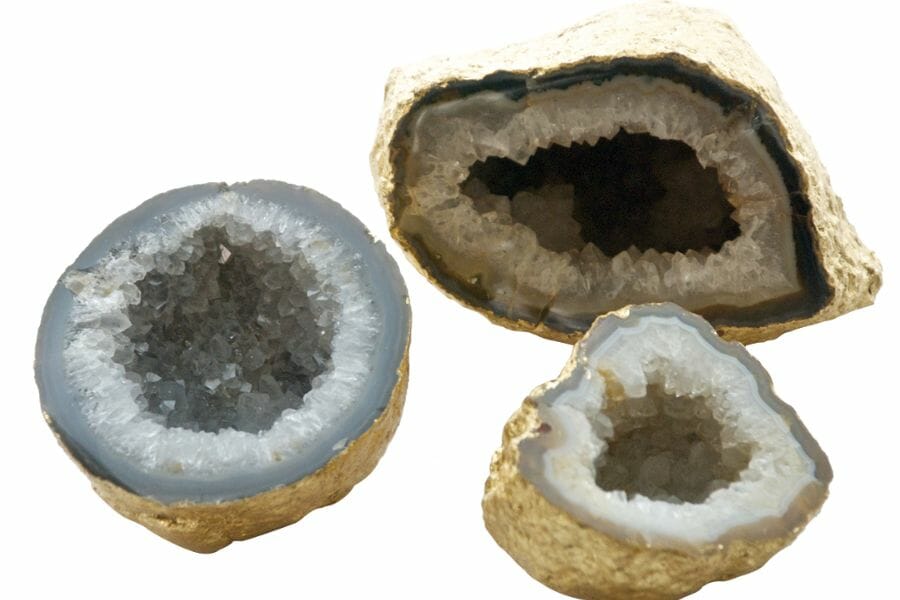Geodes are stunning and vibrant rocks that are highly sought after and can be very valuable. Roughly spherical or oval in shape, geodes are defined by a hollow cavity encompassed with beautifully layered bands of minerals and intricate arrangements of crystals.
Read on to find information on how geodes form, the different types of geodes, and tips for finding specimens in the field. In the right spot, geodes can be abundant, and you can find a geode with the right tools and knowledge. We’re going to equip you with everything you need, right here.
Where Can You Find Geodes?
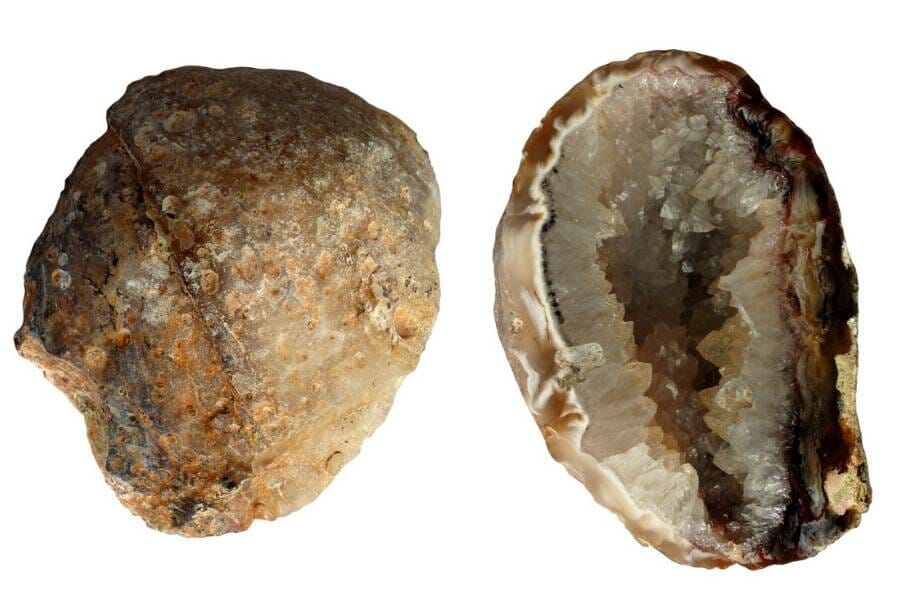
Geodes originate in either volcanic or limestone deposits, each providing distinct types of geodes with different mineral properties. How to find geodes in these environments can be tricky, but you’ll have it down pat by the end of this article.
Volcanic Geodes: Gas bubbles or vesicles form in cooling volcanic magma, most commonly in the form of bubbles of CO2 and water vapor in lava flows. After the rock has cooled and the gas has dissolved, empty space is left behind.
Limestone Geodes: Cavities in these geodes can form by mineral-dense groundwater or hydrothermal fluids that dissolve part of the rock, by the dissolution of a fossil, or by a gas pocket formed by organic matter.
Different Types of Geodes
Multiple forms of geodes occur in nature due to the different geological settings, mineral compositions, and geophysical conditions (pressure, temperature). How it looks, as well as the price and value of a geode, varies greatly depending on what it is composed of.
This is a partial list of geode types with five distinct and exciting specimens.
Agate Geodes
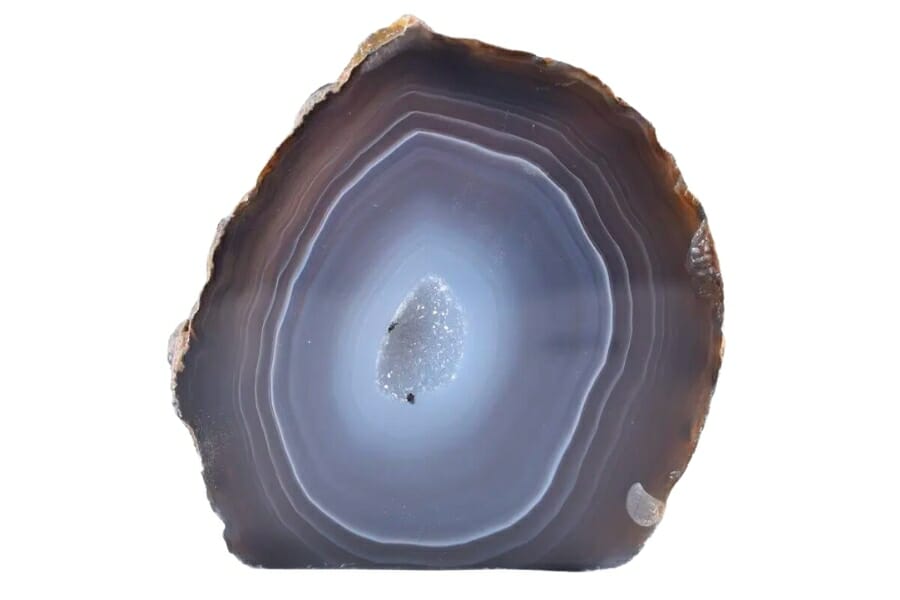
Agate geodes differ significantly from other types listed here, as the majority of the minerals deposited are concentric layers of cryptocrystalline agate, jasper, chalcedony, and associated trace minerals. There will be a small cavity at the center of the geode where minerals of quartz will form. The vibrant color zoning is due to the mineral composition, and agate is often found as nodules within the volcanic rock.
Amethyst Geodes
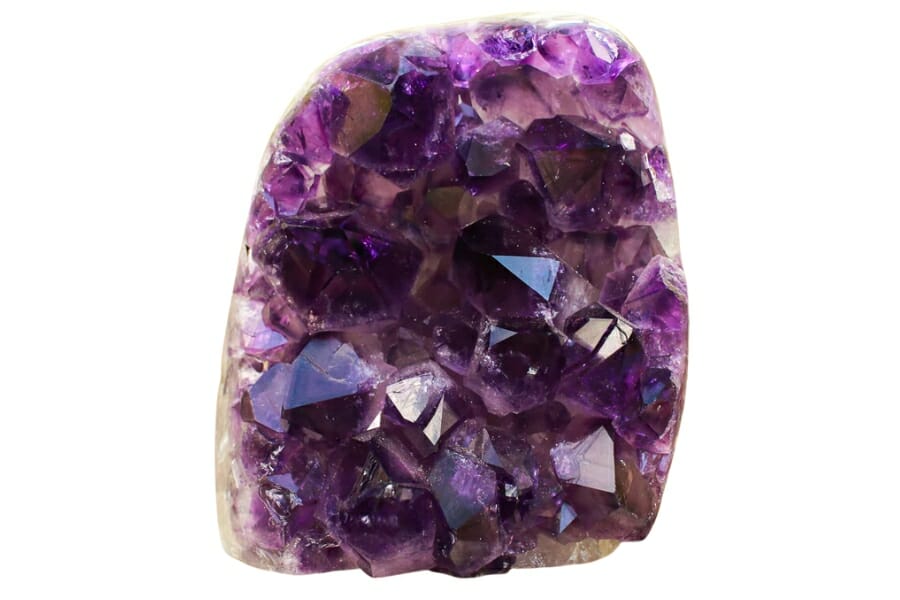
Amethyst geodes are the most sought-after and prized geode. Their radiant purple color and beautiful crystal quartz structure have captivated people throughout history. Large amethyst geode “cathedrals” ranging to meters in size typically originate in South America. Colors range from light lavenders to deep royal purples. Variations in colors are due to the presence of trace minerals and impurities in the mineral content of the rock.
Calcite Geodes
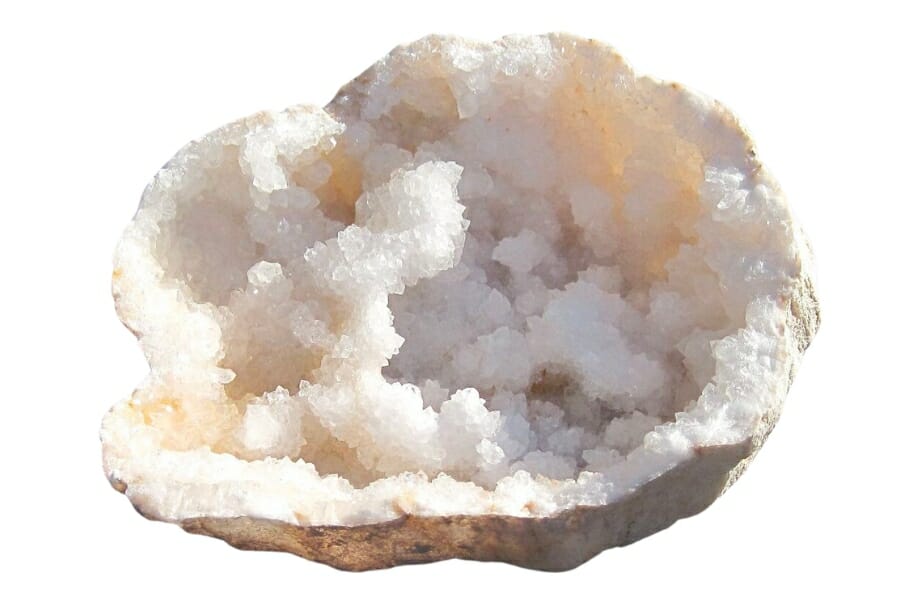
Calcite geodes are found in limestone carbonate rocks. Calcite is quite an adaptable mineral that cements minerals together in a matrix and fills gaps between crystal grains. Calcite is highly susceptible to chemical weathering that leaves voids where geode formation can begin. Calcite geodes can be associated with carbonous minerals such as aragonite and dolomite.
Celestine Geodes
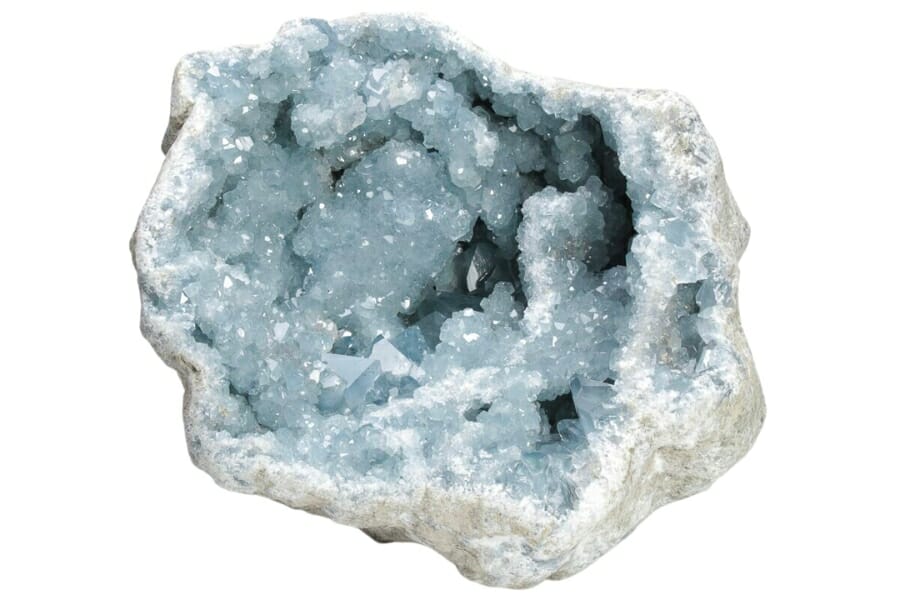
Celestine is a sulfate mineral containing strontium and is known for its light blue color. Hydrothermal solutions that include strontium will precipitate (condense) with nodules of calcium sulfate minerals like gypsum and anhydrite. This results in celestine crystals forming in the cavity. The largest geode found was in South Bass Island, Ohio. It is 11m in diameter at the highest point!
Citrine Geodes
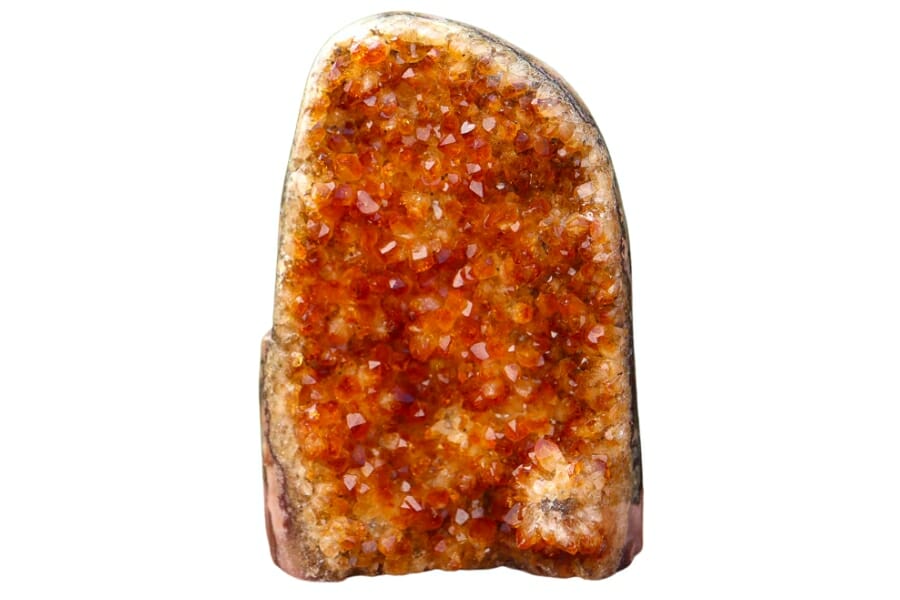
Citrine is a rare type of quartz colored yellow to orange and, like Amethyst, is very popular in the consumer market. Many large samples are found in Brazil, with some specimens ranging up to six feet high. This is a large size for a geode due to the correct conditions of pressure, temperature, and the associated trace minerals.
The Best Areas to Hunt for Geodes
Exposed surface rocks are how to spot this geode easily. Give high priority to sites that contain gullies, river and stream beds, road cuttings, building excavations or quarries. Just make sure you have permission to access these areas before you start exploring.
Rocks frequently outcrop along steep slopes. Even in locations devoid of solid rock, rockhounds can extract minerals and specimens from debris slopes, gravel deposits (including river gravels), old mine dumps, beaches, lakes, and desert regions like dried lake beds.
Where in the US You Can Find Geodes
*Click on the state above to find the guide*
Although it is possible to find geodes in almost any place with limestone or volcanic rock, geodes are most frequently discovered in dry, arid regions. In the United States, Arizona, California, Indiana, Iowa, Missouri, Illinois, Kentucky, and Utah are the most likely states to contain geodes.
Here are the best locations in the US by state for finding geodes near you:
Where to find Geodes in the USA
*Click on the links below to see the full state guide*
Geodes in Alabama
Geodes in Alaska
Geodes in Arizona
Geodes in Arkansas
Geodes in California
Geodes in Colorado
Geodes in Connecticut
Geodes in Delaware
Geodes in Florida
Geodes in Georgia
Geodes in Hawaii
Geodes in Idaho
Geodes in Illinois
Geodes in Indiana
Geodes in Iowa
Geodes in Kansas
Geodes in Kentucky
Geodes in Louisiana
Geodes in Maine
Geodes in Maryland
Geodes in Massachusetts
Geodes in Michigan
Geodes in Minnesota
Geodes in Mississippi
Geodes in Missouri
Geodes in Montana
Geodes in Nebraska
Geodes in Nevada
Geodes in New Hampshire
Geodes in New Jersey
Geodes in New Mexico
Geodes in New York
Geodes in North Carolina
Geodes in North Dakota
Geodes in Ohio
Geodes in Oklahoma
Geodes in Oregon
Geodes in Pennsylvania
Geodes in Rhode Island
Geodes in South Carolina
Geodes in South Dakota
Geodes in Tennessee
Geodes in Texas
Geodes in Utah
Geodes in Vermont
Geodes in Virginia
Geodes in Washington
Geodes in West Virginia
Geodes in Wisconsin
Geodes in Wyoming
The complex geology of the United States leads to geodes forming in various geographical settings and climate zones. Great articles on finding gems in your state can also be found here if you’re looking for some non-geode options.
How to Start Searching for Geodes
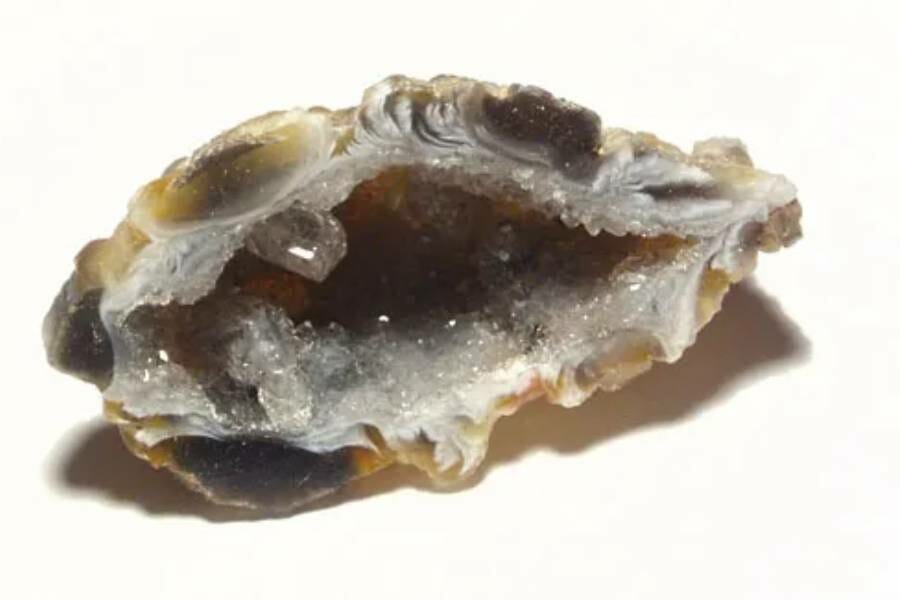
Learn Your Local Geology
How to find geodes starts with putting in some research. Planning is critical for rockhounding because you can be out there for hours without finding anything otherwise. Consulting maps, local experts, and other information online will help you learn the surroundings and where to find geodes.
Understanding the underlying geology is essential because geodes only occur in specific environments with a set number of minerals. A trustworthy resource that will give you excellent information is the National Geological Map Database which provides anyone access to geological information about any area in the US.
Know Your Community
Rockhounding is a popular pastime! Many people are passionate enough to share information and insight with those who ask. Joining a rockhounding group on social media is a significant step to learning more and possibly getting any questions you have that need answering.
Other sites like Reddit and Quora often have answered questions about geology and rockhounding. Articles like this one, as well as others found on our website, contain very concise information.
Starting Geode Hunting: What Tools and Equipment Will I Need?
You will have to venture far into the wilderness to find geodes at some locations. Pack ahead of time and be prepared for whatever can happen. If you are serious about geode hunting, the following list covers the essential equipment to help you find geodes:
- Rock hammer
- Chisel
- Hiking bag
- Plastic bag to hold rock specimens
- Safety goggles
- Notebook, pencils, and other stationery
- Proper clothing, rain gear, and hiking boots
- Food and water
- First aid kit
- Gloves
- Magnifying glass
- Maps of the area or GPS app
How to Spot a Geode
When you’re out hunting for geodes, you have to keep your head on a swivel. Rock specimens that show visible weathering are an excellent place to start. Always scan the ground to see what’s available, but be prepared to pull out your tools. Finding good samples lying on the ground is rare, and you’ll have to dig most of them out of the host rock.
Never attempt to pry your sample out of the rock. Instead, take some of the nearby rock encompassing the geode. Extracting a more extensive segment that includes the geode and outcrop safeguards the rock specimens and provides greater freedom when creating displays.
To remove your sample, use the rock’s inherent weak points and look for cleavage planes and fracturing. If there are cracks in the rock, try to drive a wedge or chisel into them. Work around the sample, but keep your distance or it could break. Take more rather than less, as you can remove the excess later. This is a great way to tell if a rock is a geode.
Mineral specimens are abundant in veins and dykes. Both develop as sheet-like bodies that cut through other rocks and frequently have larger crystals than usual. They can also be made entirely of a single precious mineral.
How to Identify Geodes
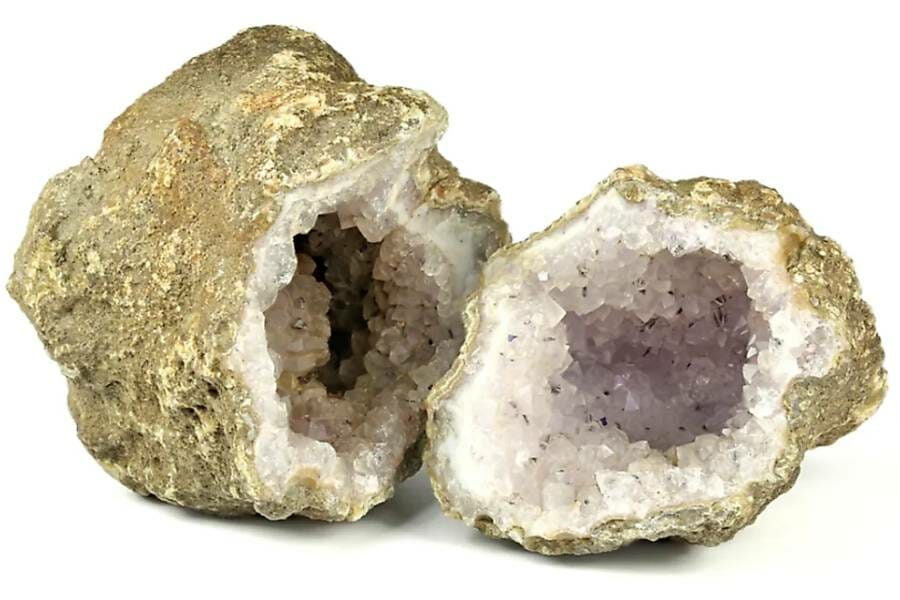
We’ve put together a full guide to identifying geodes here but we’ll also provide an overview below. A geode’s outer shell is constructed of very durable rock. Crystals can only grow inside geodes under the ideal conditions of evaporation, pressure fluctuations, and temperature.
The chalcedony that makes up the outer rind of geodes is typically rough, but just because a rock has a chalcedony shell and looks lumpy doesn’t indicate it’s a geode. You have to crack it open to see if there are crystals inside!
Geologists commonly claim that the outside of a geode has a cauliflower-like texture and is shaped like an oval. Geodes are rarely found in either smooth or jagged rocks. Weighing a suspected geode with another rock of similar size and shape is also a good indicator because the geode will be considerably lighter than the rock, due to differnces in density.
What Does a Geode Look Like?
Part of figuring out how to identify geodes is knowing what minerals they’re made of, which you can tell partly from what a geode looks like. The mineral composition of the host rock makes geodes predominantly composed of quartz and chalcedony. Quartz and chalcedony are silica minerals, but chalcedony has a cryptocrystalline (almost invisible under a microscope) texture and forms a different crystal habit than quartz.
The most common minerals found in geodes include:
- Quartz
- Chalcedony
- Agate
- Jasper
- Amethyst Quartz
- Calcite
Some less common or rare minerals found in geodes are listed in the table below:
| Anhydrite | Dolomite | Goethite | Pyrite |
| Hematite | Barite | Smithsonite | Celestine |
| Pyrite | Aragonite | Magnetite | Sphalerite |
If you are needing some more information on minerals, Mindat.org is a comprehensive database of minerals, rocks, and mineral localities. It includes information on the geology of different regions and specific locations where geodes can be found
How to Break the Outside of a Geode
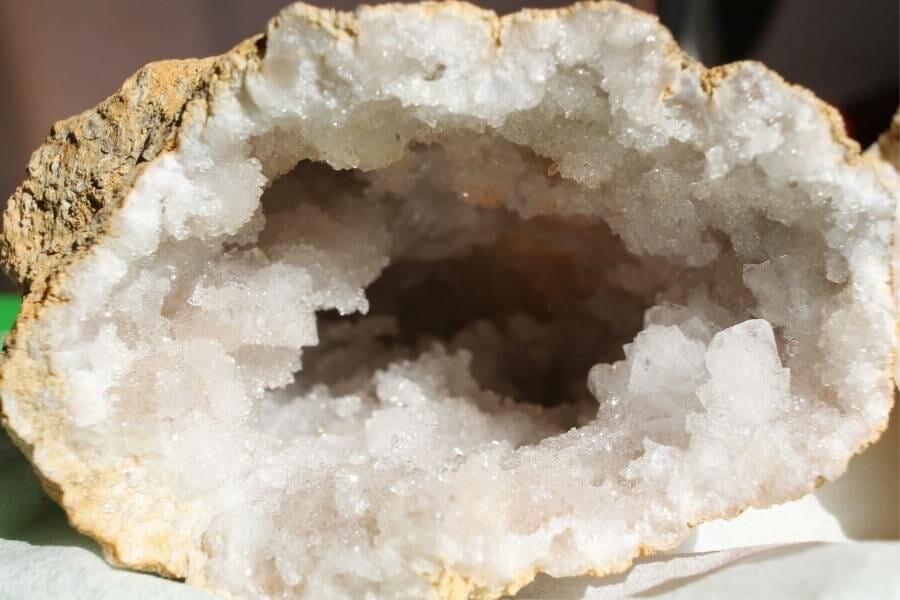
Figuring out how to identify an unopened geode will inevitably lead you to needing to open it. You will never know whether your rock is a geode until it’s cracked open. There are a few ways to crack open a geode. Some methods are a little more elegant and clean than others. Just remember your safety glasses!
- Put your geode in a sock and smash it a few times with a geology hammer. Sure, this will open your rock up, but you’ll destroy the specimen in the process. Resist the urge!
- Gently score the circumference of the geode with a chisel and a hammer. This delicate process can take some time and finesse to achieve a clean break into two halves. This method is recommended for rockhounds wanting the best-looking specimen.
- Use a diamond-quality cutting saw, which will be able to cut through samples that produce good-quality crystal faces to view minerals. However, there is a material cost that some people will want to avoid.
- Take it to a local shop and getting your specimens professionally cut and polished. This process outsources the work and can be well worth the effort and expense.
Why are Geodes so Valuable?
Humans have used geodes for thousands of years in jewelry and in trade, especially in areas with heavy mineral deposits. The alluring formation of crystals or vibrant bands of agate draw people in, and being able to handle a beautiful stone in your own hands is appealing.
Geodes are also very popular to use as decorations in homes for these reasons, so there is high market demand for them. More than just dedicated rockhounds and geology enthusiasts purchase geodes!
For information about geodes and geology in general, The Mineralogical Society of America and The American Federation of Mineralogical Societies are umbrella organizations for local rock and mineral clubs throughout the US. Their websites include information on club activities, events, and resources for rockhounding or mineral collecting.
Geodes All Over the World
While the US is truly lucky to have such geological diversity, plenty of geodes are frequently discovered in countries like Mexico, Australia, Brazil, Uruguay, and Namibia. Hunting for geodes can happen on any vacation using the tips you learned here!

